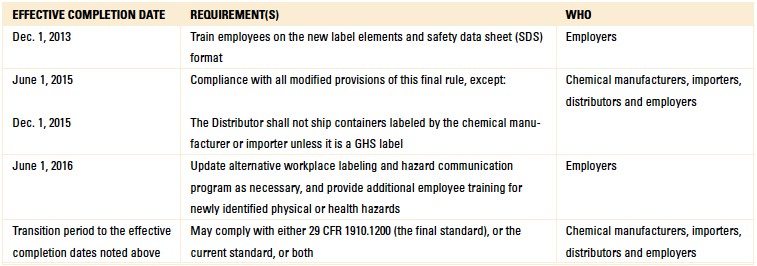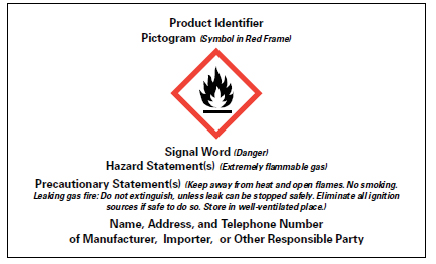Current Issue
GHS Timeline Update
The latest OSHA hazard communication requirements go into effect next year. Are you ready?
As detailed in “GHS Impacts on the EMS,”1 the Occupational Safety & Health Administration (OSHA) has adopted new requirements during its recent update of the Hazard Communication standard 29 CFR 1910.1200. The (GHS) global harmonized system standard changes a company’s hazard communication program impacting ongoing training, safety data sheet storage and chemical labeling.
Deployment of and compliance with the new regulation will continue to transition over the next few years, impacting manufacturers and all facilities that use chemicals. TABLE 1 shows requirements of the new GHS hazard communication standard.
Table 1. GHS Compliance Summary from OSHA2

GHS training. The training target date was Dec. 1, 2013, requiring employers to train employees on the new label elements and safety data sheet (SDS) format. The regulation will change the content of a company’s annual hazardous communication (HazCom) training, given the updates to standard 29 CFR 1910.1200. By now, companies have completed the initial training and have incorporated the changes of the GHS regulation into their annual hazard communication refresher and new employee orientation training.
SDS transition. Companies that use various chemicals and materials will start to see the transition to the new SDS format.
This new format will need to be catalogued, replacing the previous revision. Per regulation, safety data sheets must be available to all employees at any time. OSHA also states that no barrier should exist between the employee and retrieval of the SDS. If a facility has only an online SDS system, a contingency plan must be in place if a power outage occurs. If no contingency plan is in place, this may be considered a barrier to retrieve the SDS. Some organizations will have an online system and hard copy as a backup. If the facility has incorporated the SDS system as hard copy, the logbook must be accessible to all employees within the facility.
Secondary container labeling. If a facility transfers or pours down a chemical into a secondary container, this will be required to be labeled with the original hazard information. FIGURE 1 is an example of the label information required by the GHS.

Figure 1. GHS label example from OSHA.3
Organizations will be required to create a process to capture information from the SDS and transfer it to a label for all secondary containers. Progress has been made toward this requirement during the past few months, as some companies have designed software programs with associated label printers to complete this task. An organization should investigate how many labels would be required for a given facility to comply with the GHS. Depending on various factors and a company’s infrastructure, it may make sense to purchase the technology from a third party versus creating the process and labels in house. Either method will need to follow GHS guidelines and include the pertinent regulatory information on the pour-down label.
One challenge that may exist for a facility is small pour-down bottles and fitting all the SDS information on the label. Font size will be important, as legibility is part of the regulation. Solutions in this case may utilize pullout or “flap style” labels. In cases where labels are illegible from chemical use, chemical-resistant labels are available. Per the regulation, chemicals that are poured down and intended only for immediate use are exempt from the label requirement.
Evaluating chemical hazards. Deployment of the GHS regulation provides a standard SDS format in which an organization can evaluate the chemical hazard. Understanding the new SDS format and sections contained within will help with the evaluation. The overall goal is to assess the SDS to make sure the chemical will be safe for employees and to implement personal protective equipment before the chemical is used within a facility. It is recommended a cross-functional team review the SDS and specific chemical hazards; multiple reviewers will provide a thorough assessment. Following are some key points in the evaluation of the SDS and chemical hazards:
- Hazards identification details the hazards of the chemical and appropriate warning information associated with those hazards. This information is also detailed on the chemical labeling as precaution and hazard statements.
- Chemical composition identifies ingredients contained within the product.
- First aid, firefighting and accidental release measures detail the care, recommendations and response to exposure, fires and releases of the chemical.
- Handling and storage section provides guidance on safe work practices.
- Exposure controls and personal protective equipment (PPE) detail limits and engineering controls to minimize worker exposure.
PPE may consist of gloves, goggles and reducing air emissions through fume hoods and increased facility ventilation. Some chemicals may require exposure limit monitoring per the SDS. This monitoring can consist of air or work surface analysis, depending on the exposure and information within the SDS. After the determination by the hazard review process that PPE will be required, develop a process to deploy the safe work practices within the organization, with standardization the goal. If a chemical cannot be used safely given its properties, or the lack of personal protective equipment exists, reject or delay until equipment is deployed within the facility.
Conclusion
The global harmonized system (GHS) has changed every facility’s hazard communication program and related processes. The regulation requires standardization of safety data sheets, chemical labeling and the training of employees to these changes. The overall goal of GHS is to make it easier for chemical users to be aware of chemical hazards. By creating a robust review and implementation process of each chemical hazard, a facility will take advantage of the intent of the GHS regulation.
References
1. Scott Mazur, “GHS Impacts on the EMS,” CIRCUITS ASSEMBLY, November 2013.
2. OSHA.gov website Hazardous Communication - HazCom (Hazard Communication) standard 29 CFR 1910.1200.
3. Ibid.
is environmental management representative and manufacturing staff engineer, Benchmark Electronics (bench.com); scott.mazur@bench.com.
Press Releases
- Altus Reports Growing Demand for Guidance on Convection Reflow Oven Specification
- Coherix Opens New Adhesive-Dispensing Vision Center in Europe
- Pan Pacific Strategic Electronics Symposium Program Finalized
- The Most Critical 2 Inches in SMT Manufacturing – When a Splice Fails, the Line Fails, Full Stop. Throughput and Yield Depend on One Overlooked Moment







